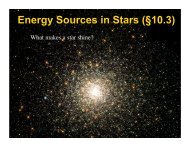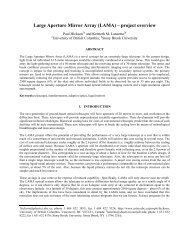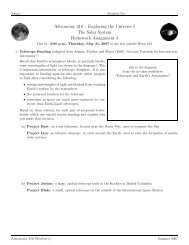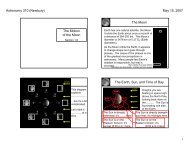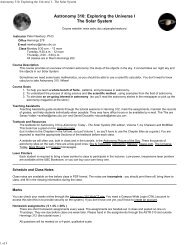Some fundamental stellar properties
Some fundamental stellar properties
Some fundamental stellar properties
You also want an ePaper? Increase the reach of your titles
YUMPU automatically turns print PDFs into web optimized ePapers that Google loves.
<strong>Some</strong> <strong>fundamental</strong> <strong>stellar</strong> <strong>properties</strong><br />
(a) Celestial Sphere, coordinates, precession, proper<br />
motions. Pre-reading pages 2 - 12 and 16 - 17.<br />
(b) Distances to stars (parallax), magnitudes, fluxes,<br />
luminosities, distance modulus. Pre-reading pages 57 -<br />
63.<br />
(c) Blackbody radiation, photometric systems,<br />
temperatures of stars. Pre-reading pages 68 - 79.<br />
(d) Stellar Spectra. Pre-reading pages 111 - 112, 114, 119 -<br />
131.<br />
(e) Masses and radii of stars from binary systems,<br />
Kepler's Laws, Mass-radius relationship. Pre-reading<br />
pages 23 - 33, 48 - 49, 180 - 198.<br />
(f) Hertzsprung-Russell Diagram, dwarf, giant and<br />
supergiant stars, white dwarfs, first clues to <strong>stellar</strong><br />
evolution. Pre-reading Chapter 8.
Basic Properties of Stars<br />
Celestial Sphere (not really a<br />
<strong>stellar</strong> property)
<strong>Some</strong> <strong>stellar</strong> statistics<br />
A few 1000 visible to the naked eye<br />
Polaris (North Star) not brightest (only 50th)<br />
Sirius is brightest
SOME STELLAR STATISTICS<br />
A few billion stars can be seen with best<br />
telescopes (not counting distant galaxies<br />
where individual stars generally<br />
unresolved but light is still detected).<br />
Estimate # of stars in observable Universe<br />
~ 10 23<br />
Nearest star (Proxima(<br />
Centauri) is 300,000<br />
times more distant than Sun.<br />
(by comparison, Neptune is 30 times<br />
farther than Sun).
Small and Great Circles<br />
Small Circle: Curve on sphere<br />
produced by plane NOT<br />
containing the centre.<br />
Great Circle: Curve on sphere<br />
when plane contains centre.<br />
The line perpendicular to plane<br />
that passes through the centre<br />
intersects sphere at poles P, P’.<br />
Only 1 great circle passes<br />
through any 2 given points on<br />
sphere, Q, Q’. Arc QQ’ is<br />
shortest distance between these<br />
points.
Location of a Point on a Sphere<br />
Either XYZ coordinates<br />
or 2 angles, ψ and θ,<br />
can be used to locate a<br />
point, P, on the surface<br />
of a unit sphere.<br />
Note that for angle, ψ,<br />
a reference point<br />
along the equator is<br />
required.
Latitude, Longitude on Earth<br />
Reference plane is equator.<br />
Small circles parallel to equator<br />
are parallels of latitude. + north,<br />
- south.<br />
Altitude of celestial pole is your<br />
latitude. (Vancouver)<br />
Semicircles from pole to pole<br />
are meridians.<br />
Longitude is angle between<br />
meridian and zero meridian<br />
(Greenwich). + west, - east.
CELESTIAL SPHERE §1.3
Celestial Sphere
APPARENT SKY ROTATION
STAR CIRCLES
STAR TRAILS NEAR THE<br />
POLE
EQUATORIAL STAR TRAILS
INTERMEDIATE LATITUDE<br />
STAR TRAILS
EARTH SPINS on its AXIS<br />
Stars seem to revolve<br />
around the celestial<br />
pole.
FLASHCARD<br />
FOR ABOUT HOW LONG WAS THE CAMERA<br />
OPEN IN THIS PICTURE<br />
A) 30 seconds<br />
B) 5 minutes<br />
C) 2 hours<br />
D) 5 hours
Earth’s s Inclined Axis<br />
Earth’s s axis inclined 23.5 degrees<br />
to plane of its orbit
SEASONS on EARTH
The Sun follows a well-defined path<br />
Origin of time-keeping.
Sun's apparent motion across the<br />
sky just caused by Earth's orbit.<br />
Sun 'moves' in front of 12 constellations; the<br />
zodiac.
Right Ascension and Declination<br />
γ is position of<br />
crossing of celestial<br />
equator and<br />
equatorial plane of<br />
Earth - position of<br />
vernal equinox. This<br />
is a fixed point from<br />
which to measure<br />
angles.<br />
α is Right Ascension<br />
δ is Declination
EARTH’S S PRECESSION<br />
Most members of Solar System are near ecliptic, and tend to pull<br />
equatorial bulge of Earth towards it. Mostly due to Moon and Sun.<br />
Because Earth rotating, this torque cannot change inclination of<br />
equator to ecliptic, but causes rotation axis to turn in a direction<br />
perpendicular to axis and torque, describing a cone (P = 26,000 yr).
PRECESSION p.12 - 14<br />
Precession of<br />
pole is slow.<br />
Angle of<br />
inclination does<br />
not change.<br />
Precession<br />
changes<br />
position of NCP<br />
and γ, , so we<br />
must define<br />
when α and δ<br />
are measured.
EARTH’S S PRECESSION
EARTH’S S PRECESSION
<strong>Some</strong> precession details<br />
Polaris is currently within 1 degree of pole. Where will it<br />
be in 13,000 years<br />
Same effect causes 50.3”/year westward motion of vernal<br />
equinox - use tropical year for calendar.<br />
J2000 is reference (Jan 1, 2000 noon at Greenwich)<br />
Δα = [ m + n sin α tan δ ] N Eq 1.2 and 1.3 in text<br />
Δδ = [n cos α] ] N<br />
N = # years between desired time and reference epoch<br />
(can be negative), and m = 3.07419s/yr, n = 20.0383”/yr<br />
for reference epoch = 2000. Eg 13,000 years from now,<br />
where will Polaris be




